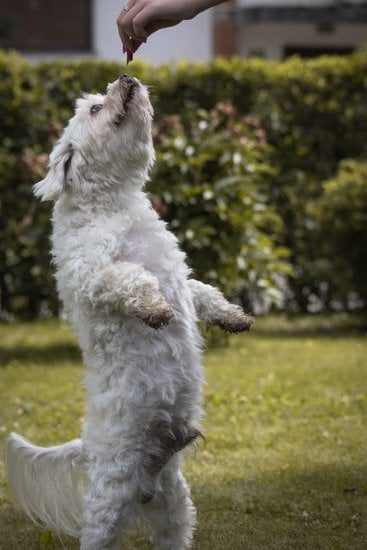When it comes to training our canine companions, there are countless methods and techniques that claim to be effective. However, one particularly shocking and widely misunderstood approach is the belief that beating a dog is necessary for successful training. This article will delve into this controversial topic, debunking the myth of beating dogs for training and shedding light on more humane and effective alternatives.
It is essential to address the common misconception that physical punishment, such as hitting or beating, is required to discipline a dog effectively. In reality, this belief not only threatens the well-being of our beloved pets but also undermines an entire field of psychology-backed training techniques based on positive reinforcement. Positive reinforcement is far more conducive to creating a strong bond between owner and dog while instilling obedience without resorting to fear or pain.
Physical punishment can have significant negative consequences on a dog’s mental well-being. Research has shown that dogs subjected to physical abuse during training are more likely to develop anxiety, fearfulness, and even aggression. This stems from the fundamental understanding that dogs respond better when they feel safe and loved rather than when they face pain or fear. With this in mind, it becomes evident why beating dogs as a training method is both counterproductive and cruel.
Understanding the Psychology Behind Dog Training
Dog training is a complex process that requires an understanding of canine psychology. By delving into the psychological aspects of dog training, trainers can develop effective and humane methods to shape desired behaviors in dogs. This section will explore the principles of operant conditioning, the power of positive reinforcement, and the negative impact of fear-based training techniques on a dog’s mental well-being.
Principles of Operant Conditioning
One key aspect of understanding dog training psychology is recognizing the principles of operant conditioning. Developed by psychologist B.F. Skinner, this theory explains how behavior is influenced by consequences. In dog training, trainers use rewards or punishments to strengthen or weaken specific behaviors.
Positive reinforcement is one approach within operant conditioning that proves to be highly effective in shaping a dog’s behavior. By rewarding desired behaviors with treats, praise, or play, trainers are able to increase the likelihood that the behavior will be repeated. Rather than relying on punishment and force, trainers focus on reinforcing positive behaviors to guide dogs towards desired outcomes.
The Power of Positive Reinforcement
Positive reinforcement is a vital component of successful and humane dog training. When used correctly, positive reinforcement not only promotes obedience but also strengthens the bond between owner and pet. Dogs learn through a process called associative learning, where they make connections between actions and consequences. By consistently associating desired behaviors with rewards, dogs understand what is expected from them and are motivated to repeat those behaviors.
Furthermore, positive reinforcement techniques contribute to a dog’s mental well-being by creating an environment based on trust and positivity rather than fear or intimidation. It encourages dogs to use their natural problem-solving abilities as they strive for rewards rather than merely avoiding punishment.
The Negative Impact of Fear-Based Training Techniques
Fear-based training techniques have long been criticized due to their potential harm to dogs both mentally and emotionally. Trainers who use fear and intimidation methods may achieve short-term results, but the long-term consequences can be detrimental to a dog’s overall well-being.
Fear-based training techniques such as physical punishment, yelling, or aversive tools not only harm a dog physically but also lead to behavioral issues such as aggression and anxiety. Dogs trained through fear often become anxious in new situations or around unfamiliar people. This fear can manifest in aggressive behaviors as a defense mechanism.
Understanding the psychological impact of different training methods is crucial for promoting the well-being of dogs. By using positive reinforcement techniques rooted in operant conditioning principles, trainers can shape behaviors effectively while fostering a healthy and trusting relationship with their canine companions.
The Advantages of Positive Reinforcement Training Methods
Positive reinforcement training methods have gained immense popularity in recent years for their effectiveness and humane approach to dog training. This section will explore the advantages of using positive reinforcement techniques with dogs, highlighting how they build trust, strengthen bonds, and enhance obedience.
Benefits of Positive Reinforcement Techniques
One of the primary advantages of positive reinforcement training methods is that they focus on rewarding desired behaviors rather than punishing unwanted ones. By rewarding a dog for performing a desired behavior, such as sitting or coming when called, the dog learns to associate that behavior with positive outcomes. This creates a strong motivation for the dog to repeat the behavior in the future. Positive reinforcement strengthens the bond between owner and dog as it builds trust and mutual understanding.
Furthermore, using positive reinforcement techniques allows owners to communicate clearly with their dogs. Dogs are able to understand that they are being rewarded for specific actions or behaviors, making it easier for them to grasp what is expected of them. This clarity in communication helps prevent confusion and frustration during training sessions.
Success Stories and Scientific Evidence
Numerous success stories attest to the effectiveness of positive reinforcement training methods. Dogs who have been trained using these techniques are often highly obedient, well-behaved, and eager to please their owners. Many dogs trained with positive reinforcement methods excel in various sports and activities like agility or obedience trials.
Scientific research also supports the benefits of positive reinforcement training methods. Studies have shown that dogs trained using rewards rather than punishment exhibit lower stress levels, increased motivation, improved problem-solving abilities, and enhanced overall well-being. Positive reinforcement allows dogs to learn in a stress-free environment where they feel comfortable expressing themselves.
Exploring Alternatives to Physical Punishment
In this section, we will explore alternatives to physical punishment for training dogs. Physical punishment, such as beating or abusing dogs, is not only cruel and inhumane but also ineffective in achieving long-term behavior change. Instead, positive reinforcement techniques offer a more compassionate and effective approach to dog training.
One popular alternative to physical punishment is clicker training. This method involves using a small handheld device that makes a distinct sound when pressed. The sound is then paired with a reward, such as a treat or praise, to reinforce desired behaviors. Clicker training helps clarify the exact moment the dog performed the desired behavior, making it easier for them to understand and learn.
Another alternative is shaping, which involves breaking down complex behaviors into smaller achievable steps. By rewarding the dog for each step towards the desired behavior, they gradually learn and build upon their skills. Shaping allows dogs to actively participate in their training and encourages them to think and problem-solve.
Target training is also an effective alternative to physical punishment. This technique involves using a target stick or mat that the dog can touch with their nose or paw on command. By associating specific actions with target touching and rewarding those actions consistently, dogs can learn new behaviors while having fun.
Consistency, patience, and encouragement are key factors in successful positive reinforcement training. It’s important for owners to set clear expectations for their dogs and be consistent with their rewards and cues. Additionally, being patient during the learning process and providing encouragement when progress is made helps establish trust between the owner and dog.
| Alternative Training Methods | Description |
|---|---|
| Clicker Training | Uses a distinct sound, like a clicker, to mark desired behaviors and pairs it with a reward. |
| Shaping | Involves breaking down complex behaviors into smaller achievable steps and gradually rewarding progress. |
| Target Training | Uses a target stick or mat for the dog to touch with their nose or paw on command and rewards those actions consistently. |
By adopting these positive reinforcement techniques, owners can build a strong bond of trust with their dogs while achieving desired training outcomes. It’s important to remember that dogs are sensitive creatures who respond best to respectful and humane training methods.
The Harmful Effects of Beating or Abusing Dogs for Training
Physical punishment, such as beating or abusing dogs, for training purposes is not only unnecessary but also harmful to the well-being of our furry friends. Understanding the negative effects of such techniques is crucial in advocating for compassionate and effective training methods.
Beating or abusing dogs during training can have profound physical and emotional consequences. Physically, these actions can lead to severe injuries, including broken bones, internal bleeding, and organ damage. Furthermore, traumatic experiences like these can result in behavioral issues such as increased fear and aggression. Dogs that have been abused may develop trust issues and become fearful or defensive in future interactions.
Emotionally, dogs subjected to beating or abuse suffer significant psychological distress. These experiences can lead to anxiety disorders, post-traumatic stress disorder (PTSD), depression, and a decreased quality of life. Such trauma can affect their ability to learn and inhibit their overall well-being.
It is essential to address misconceptions surrounding the use of physical violence in dog training and educate pet owners about alternative methods that are more humane and effective. Positive reinforcement-based techniques focus on rewarding desired behaviors rather than punishing unwanted ones. By using treats, praise, toys, or other rewards during training sessions, dogs are motivated to repeat behaviors that result in positive outcomes.
The benefits of positive reinforcement methods extend beyond just the absence of harm; they promote trust between the dog and its owner, strengthen the bond between them, encourage obedience without instilling fear or anxiety, and enhance overall communication skills. Various studies have demonstrated the effectiveness of positive reinforcement training in achieving long-lasting behavior changes in dogs.
Choosing non-violent approaches to dog training not only benefits the individual pet but also contributes to a more compassionate society for all animals. By promoting positive reinforcement techniques over abusive practices, we can create a safer environment where animals are treated with respect and understanding.
Famous Dog Trainers and Their Non-Violent Techniques
In the world of dog training, there are several well-known trainers who have achieved remarkable results without resorting to violence or physical punishment. These trainers have pioneered non-violent techniques that focus on positive reinforcement and building a strong bond between dogs and their owners. By highlighting their success stories and positive techniques, it becomes clear that beating a dog is unnecessary for effective training.
One such renowned dog trainer is Cesar Millan, popularly known as the “Dog Whisperer.” Millan emphasizes the importance of understanding a dog’s needs and using calm assertiveness to establish leadership. His methods involve setting boundaries, providing consistent structure, and reinforcing desired behaviors through positive rewards. His approach has proven successful in rehabilitating even the most challenging cases.
Another notable trainer is Zak George, a YouTube sensation known for his positive reinforcement techniques. George believes in using rewards such as treats, toys, and praise to motivate dogs and shape their behavior. He uses clicker training, which involves marking desirable behaviors with a distinctive sound followed by a reward. His methods are centered on building trust and creating a joyful learning environment for both dogs and owners.
Victoria Stilwell is yet another prominent figure in non-violent dog training. She advocates for positive reinforcement methods that prioritize rewarding good behavior rather than punishing undesirable actions. Stilwell focuses on teaching alternative behaviors while redirecting dogs away from negative habits. Her compassionate approach has helped countless dogs overcome fear-based issues and build confidence.
These famous dog trainers serve as role models for pet owners seeking effective alternatives to physically punishing their dogs. Their success stories demonstrate that by using methods rooted in kindness, respect, and communication, it is possible to train dogs without causing harm or instilling fear.
| Dog Trainer | Main Techniques | Success Stories |
|---|---|---|
| Cesar Millan | Establishing leadership, setting boundaries, positive rewards | Rehabilitating challenging cases, resolving behavioral issues |
| Zak George | Positive reinforcement, clicker training, joyful learning environment | Shaping behavior, building trust, creating a strong bond |
| Victoria Stilwell | Rewarding good behavior, teaching alternatives, building confidence | Overcoming fear-based issues, promoting a harmonious relationship |
Tips for Effective Positive Reinforcement Training
Positive reinforcement training is a powerful and effective method of training dogs that focuses on rewarding desired behaviors rather than punishing unwanted ones. When implemented correctly, positive reinforcement training can build trust, strengthen the bond between owner and dog, and enhance obedience. Here are some tips for effectively using positive reinforcement methods in your dog’s training:
- Use a clicker or marker word: A clicker or marker word (such as “yes” or “good”) is a valuable tool in positive reinforcement training. It allows you to precisely mark the moment your dog exhibits the desired behavior, which helps them better understand why they are being rewarded. Pair the click or marker word with a treat or reward to reinforce the behavior.
- Reward immediately: Timing is crucial in positive reinforcement training. The reward should be given immediately after your dog performs the desired behavior to ensure they make the connection between their action and the reward. Delaying the reward could cause confusion or reinforce the wrong behavior.
- Be consistent: Consistency is key to successful positive reinforcement training. Set clear expectations and rewards for your dog’s behavior and follow through consistently each time they exhibit that behavior. This will help your dog understand what is expected of them and increase their chances of repeating the behavior.
- Keep training sessions short and frequent: Dogs have short attention spans, so it’s important to keep training sessions short (about 5-10 minutes) and frequent throughout the day. This will prevent mental fatigue, keep your dog engaged, and make learning more enjoyable for both of you.
- Be patient and persistent: Training takes time, so patience is essential when using positive reinforcement techniques. Remember that every dog learns at their own pace, and it’s important to persist even when faced with challenges or setbacks.
- Provide variety in rewards: Dogs can get bored with repetitive treats or rewards, so it’s beneficial to offer a variety of rewards during training. Experiment with different treats, toys, or affectionate praise to keep your dog motivated and engaged.
By following these tips, you can effectively implement positive reinforcement training methods and reap the benefits of a well-behaved, happy, and confident dog. Remember, positive reinforcement is not just about shaping behavior; it is also about creating a loving and respectful relationship with your furry companion.
Addressing Misconceptions and Critics of Positive Reinforcement Training
Positive reinforcement training has gained popularity in recent years for its effectiveness and humane approach to dog training. However, there are still misconceptions and critics who believe that positive methods are too lenient or ineffective. In this section, we will address these misconceptions and provide evidence-based counterarguments to support the use of positive reinforcement training methods.
One common argument against positive reinforcement training is the belief that it is too time-consuming or difficult. Critics claim that using treats or rewards for every desired behavior can be impractical in real-life situations. However, it is important to note that positive reinforcement involves more than just using treats as rewards.
It also includes praise, petting, playtime, and other forms of positive attention. Incorporating these into daily interactions with your dog can make the training process seamless and enjoyable.
Another misconception is that positive reinforcement techniques only work for basic commands or tricks, and not for addressing behavioral issues such as aggression or anxiety. However, studies have shown that positive reinforcement can effectively address a wide range of behavioral problems in dogs. By focusing on rewarding desired behaviors rather than punishing unwanted ones, dogs learn to associate good behavior with positive outcomes. This helps them develop confidence, reduce anxiety, and improve their overall well-being.
Critics may argue that punishment-based methods yield faster results compared to positive reinforcement techniques. While it’s true that punishment may suppress certain behaviors temporarily, it does not address the underlying causes of those behaviors nor encourage long-term change. Additionally, physical punishments can lead to fear or aggression in dogs as they associate training sessions with pain or discomfort.
Experts in dog behavior and training consistently advocate for the use of positive reinforcement methods because they prioritize the emotional well-being of dogs while producing long-lasting results. Not only do these techniques foster trust between you and your furry friend, but they also strengthen the bond you share.
Conclusion
In conclusion, it is crucial to debunk the myth that beating dogs is necessary for effective training. The understanding of the psychology behind dog training reveals that positive reinforcement methods are far more effective and humane. By utilizing operant conditioning principles and focusing on rewards and positive techniques, we can shape a dog’s behavior while ensuring their mental well-being.
The advantages of positive reinforcement training methods cannot be overstated. Not only does it build trust and strengthen the bond between humans and dogs, but it also enhances obedience. Scientific evidence and success stories abound, demonstrating the positive impact of this approach. Through consistency, patience, and encouragement, owners can successfully train their dogs without resorting to physical punishment.
It is important to highlight the harmful effects of beating or abusing dogs for training purposes. Such actions not only cause physical harm but also lead to increased fear, aggression, and behavioral issues in dogs. The stories of rescued dogs who have overcome trauma through positive training methods serve as inspiring examples of how love, compassion, and non-violence can transform lives.
In the world of dog training, there are many renowned experts who have achieved remarkable results without resorting to violence or forceful techniques. Trainers like Cesar Millan, Zak George, and Victoria Stilwell embrace positive training methods that promote respect and understanding between humans and dogs.
It is essential for readers to understand that using non-violent methods in dog training is not only just but also humane. By embracing positive reinforcement as a more compassionate alternative to physical punishment, we contribute to the overall well-being of our beloved canine companions. Let us appreciate that each dog deserves love, care, and a life free from fear or abuse – choosing a humane approach to training ensures their happiness and strengthens our bond with them.
Frequently Asked Questions
How do you discipline a puppy that won’t listen?
Discipline for a puppy that won’t listen requires patience, consistency, and positive reinforcement rather than punishment. It is important to remember that puppies are still learning and understanding their boundaries. One effective approach is to redirect their attention when they misbehave by offering an alternative behavior or distraction.
For example, if a puppy starts chewing on furniture, quickly removing the object and providing them with an appropriate chew toy can help teach them what’s acceptable. Reinforcing desired behaviors with treats or praise also helps them understand what you expect from them. Another helpful strategy is to establish a clear routine and provide regular exercise to prevent excessive energy that can lead to disobedience.
Does smacking a dog on the nose work?
Smacking a dog on their nose is not recommended as an effective method of discipline. While it may stop a specific behavior in the moment, physical punishment can lead to negative consequences and potential long-term behavioral issues.
This approach often creates fear or anxiety in dogs, which can damage the bond between the owner and pet while causing emotional distress for the dog. It’s crucial to promote positive training methods based on praise, rewards, and redirection instead of resorting to physical force.
How do you punish a puppy for misbehaving?
Punishing a puppy for misbehavior should focus on redirection and teaching appropriate behaviors rather than strict punishment practices. Effective techniques involve reinforcing desired behaviors through positive reinforcement strategies such as treats, praise, or playtime as soon as they demonstrate good behavior. However, if necessary, time-outs can be used as a form of consequence for more severe misbehavior like excessive biting or aggression.
Placing the puppy in a quiet area without stimulation for a short period allows them time to calm down and encourages them to associate their negative behavior with the lost opportunity for attention or playtime. Additionally, positively reinforcing appropriate behaviors will ultimately shape their conduct more effectively than harsh punishments ever could.

Welcome to the blog! I am a professional dog trainer and have been working with dogs for many years. In this blog, I will be discussing various topics related to dog training, including tips, tricks, and advice. I hope you find this information helpful and informative. Thanks for reading!





